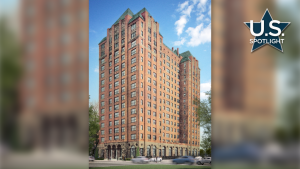The U.S. government has declared sweeping tariffs of 10 per cent on all imports, plus what it called reciprocal tariffs on a host of countries.
According to The Economist newspaper, imports will now face a weighted average tariff rate of nearly 24 per cent.
Canadian and Mexican goods that comply with the United States-Mexico-Canada free trade agreement — except for steel and aluminum — will be exempt from reciprocal tariffs.
Peter Tateishi, CEO of Associated General Contractors of California (AGC of CA), says the tariffs will have a negative impact on the cost and availability of imported building materials that will be needed to rebuild those parts of Los Angeles that were destroyed in the January fires.
“There’s a lot of construction going on in southern California right now,” says Tateishi. “There’s the Los Angeles Convention Centre remodeling project as well as infrastructure development for the 2026 World Cup and 2028 Summer Olympics. Many building materials need to be imported, and the higher prices caused by the tariffs will increase competition for them.”
Fourteen destructive wildfires hit the Los Angeles metropolitan area between Jan. 7 and Jan. 31.
The fires were made even more damaging by drought conditions, a buildup of combustible vegetation from the previous winter and hurricane-force winds, which in some places reached 100 miles per hour.
The wildfires killed at least 30 people, forced more than 200,000 to evacuate, and destroyed more than 18,000 homes and structures. The wildfires burned over 57,000 acres of land.
Most of the damage was caused by the two largest fires: The Eaton Fire in Altadena and the Palisades Fire in Pacific Palisades, both in northern LA County.
The deaths and damage to property from the two fires made them among the most destructive conflagrations in California’s history.
The after-fire clean-up is proceeding in two phases, says Tateishi.
AGC of CA has been working with the state government to help co-ordinate the clean-up.
Phase one, the removal of hazardous materials, was completed by the end of February 2025.
The Federal Emergency Management Agency (FEMA) assigned the US Environmental Protection Agency (EPA) to assess, remove and safely dispose of hazardous materials from all burned areas.
As part of their work, EPA crews removed and disposed of more than 1,000 lithium-ion batteries from vehicles, homes and other battery powered products.
Staging areas were set up to sort and package the hazardous materials. Afterward, EPA carried out soil sampling at each staging area to ensure there was no environmental impact.
FEMA also assigned EPA to provide water infrastructure technical assistance.
Phase two of the clean-up, debris removal, is being carried out now by the U.S. Army Corps of Engineers on behalf of FEMA.
It takes two to three days per property for debris to be safely removed, so it will take some time to clean up all the debris from the fires.
In addition, the time it takes to complete the job can change, because it depends on many variables – the amount of debris, the degree of damage, the amount of concrete and hard landscaping materials, the condition of the foundation, the size of the lot or parcel as well as weather conditions.
“Some of our members, especially heavy civil and heavy utility contractors, have been taking part in debris removal,” says Tateishi.
The California construction industry is busy, but it is also has some concerns.
According to a recent AGC of CA survey, members said they were concerned about workforce development, the state and federal regulatory environment and increasing wages and benefits.
On top of that, there are the U.S. tariffs that will raise the price of building materials.
“The president says the tariffs will lead to billions of dollars of new investment,” says Tateishi. “But the tariffs will increase the cost of materials, so the construction industry is stuck in the middle.”












Recent Comments